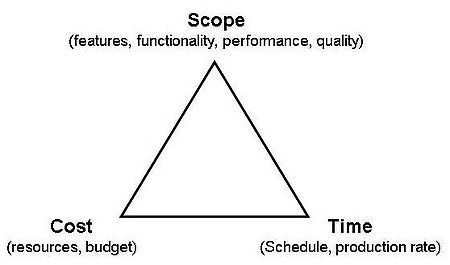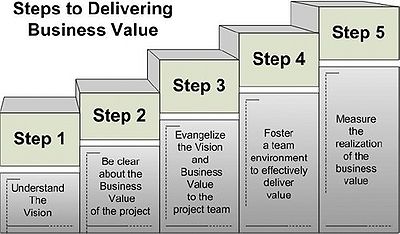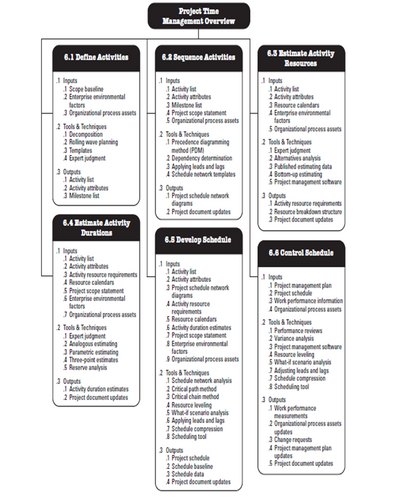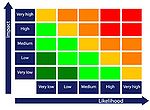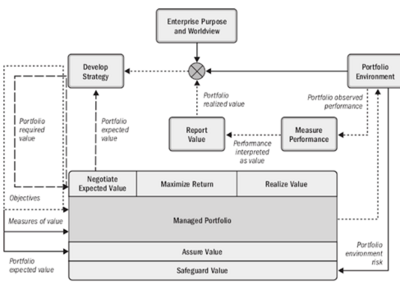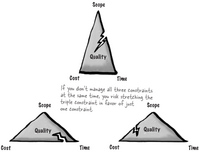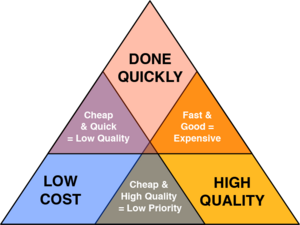Project Management Triangle
The Project Management Triangle (called also Triple Constraint or the Iron Triangle) is a model of the constraints of project management.The triangle is used by managers to analyze or understand the difficulties that may arise due to implementing and executing a project.It is used to illustrate that project management success is measured by the project team's ability to manage the project, so that the expected results are produced while managing time and cost.All projects irrespective of their size will have many constraints.Although there are many such project constraints, these should not be barriers for successful project execution and for the effective decision making.There are three main interdependent constraints for every project; time, cost and scope.[1] They are a part of every project and though they can be limiting, when properly managed they should not affect a successful project outcome. These are often characterized in the Project Management Triangle.
If we broaden this view and talk about projects, the triangle is a necessity for any project regardless of its size and nature. All three factors in the triangle have a single bounding force, i.e. “project success”. These constraints are highly interrelated to each other and any change in any one of the factor will affect the other two factors negatively or positively.The purpose of any Project Manager is to maintain a balance between the three factors to make the project successful. In most of the projects the shape of the triangle will not be equilateral because of the change in cost, scope and might be time over the cycle of the project. For example change in cost of work will surely affect the scope and time or change in scope will affect the other two factors. In well-defined projects (where scope definition is clear and detailed) there are fewer chances that the triangle will change its shape by great differences and in any poorly defined project it is vice versa, therefore it is always a good idea for Project Managers to put considerable amount of effort & time to outline the scope of the project as detailed as possible so there will be fewer chances in the variation of cost and time.Quality is another dimension which is related to PMT and many people believe that the outcome of triple constraint is quality. Majorly quality can be improved by increasing the cost and resources but as a project management professional we should keep the quality bench marks as such where cost should not increase beyond the acceptable level. It’s a good practice for project managers to keep routine checks on the progress of project and to use correct and efficient resources to perform tasks. Sometime critical path reorganization and to make critical activities parallel (if possible) to each other also results in terms of efficient outcomes for time, cost and scope scheduling.[2]
Contents |
The Three Constraints
The three constraints in a project management triangle are scope, time and cost. These three factors are represented as a triangle (Figure 1). Equilateral triangle shows a balance and ideal condition between time, cost and scope. The Project Manager should aim to maintain a balance between these three factors to make the project successful. In most of the projects the shape of the triangle will not be equilateral because of the change in cost, scope or time over the cycle of the project. For example, change in scope of work will surely affect the cost and time or change in cost will affect the other two factors.[1]
Time
A project's activities can either take the same time as planned or may take shorter or longer time. Completion of tasks depends on a number of factors. On the other hand, failure to meet the deadlines in a project can create adverse effects. As the saying goes, time should be regarded as equivalent to money. When the project's time is reduced, either the cost needs to be increased or scope needs to be reduced. Time constraint can begin as early as the start of the project. While the goal of project management is to begin a task when ready and complete it as early as possible, some factors can limit the progress of the team. That can be specific issues like resource availability or delays over which the project manager has no control. Most projects have deadlines, whether they’re formal requirements from a client or informal in-house expectations. This prevents projects from going over the deadline or using up resources long after the original purpose of the project is forgotten. Reaching that deadline is the task that project managers tend to focus on, because it’s the most definitive. If a project isn’t finished on schedule, it can affect the revenue earned for the task and injure the reputation of both the project manager and the company that employs him. [1]
Cost
The second element of the Triangle is known as either Cost. Resources always cost money so the two are interchangeable in many ways. When we talk about the cost of a project, we are talking about what needs to be applied or assigned to the project in terms of money and effort in order to make things happen. This can be resources like manpower/labor or can be materials needed to perform the job or any third party resources that might need to be secured. It’s imperative for both the project manager and the organization to have an estimated price when undertaking a project. Budgets will ensure that project is developed or implemented below a certain cost. Sometimes, project managers have to allocate additional resources in order to meet the deadlines with a penalty of additional project costs. [1]
Scope
Scope looks at the outcome of the project undertaken. This consists of a list of deliverable, which needs to be addressed by the organization responsible for the project. A project manager will know to manage both the scope of the project and any change in scope which impacts time and cost. Sometimes projects fail on this constraint because the scope of the project is either not fully defined or understood from the start. When the project's scope is increased, either cost has to be increased or time. It is the responsibility of the project manager to state what is important; for example, the project must cost no more than the allocated budget, be delivered by a particular date, or contain certain features. [1]
Quality question- Where it should be added?
Even before giving the answer of this question, one should understand that what is quality and how it is related to three constraints. Quality is an outcome and not the constraint itself. The outcome of the Project Management Triangle is the finished project either with bad, good or acceptable quality. The equal or the more appropriate word is balanced share of all three constraints will comprise the overall quality. Percentage wise 33.33% share from each of the three constraints will result into a well-balanced project/product. The word high quality is not used (instead using well-balanced) because the definition of quality is vast and varies as per the acceptance and satisfactory level. Whereas on the client/stakeholder side expectations should be limited, based on the limitations of scope, time & cost (most of the client either neglect that understanding or try to achieve three bananas in the price of one). In simple terms, the quality is another triangle inside the triple constraint triangle and all sides of the inside triangle are linked with the outer boundaries, if the inner triangle (quality-all three sides) is completely met with the outer triangle that means project is on its maximum quality level on the given limitations of scope, time & cost. [2]
Managing the Constraints:
Project Scope Management
Project Scope Management includes the processes required to ensure that the project includes all the work required, and only the work required, to complete the project successfully. Managing the project scope is primarily concerned with defining and controlling what is and is not included in the project.
According to the Project Management Body of Knowledge (PMBOK) the Project Scope Management processes include the following: [3]
- Plan Scope Management
- Collect Requirements
- Define Scope
- Create WBS
- Validate Scope
- Control Scope
- Product scope
- Project scope
Plan Scope Management
Plan Scope Management is the process of creating a scope management plan that documents how the project scope will be defined, validated, and controlled. The key benefit of this process is that it provides guidance and direction on how scope will be managed throughout the project.[3]
- Input : Project management plan, Project charter, Enterprise environmental factors, Organizational process assets.
- Tools & Techniques : Expert judgement, Meetings.
- Outputs : Scope management plan, Requirements management plan
Collect Requirements
Collect Requirements is the process of determining, documenting, and managing stakeholder needs and requirements to meet project objectives. The key benefit of this process is that it provides the basis for defining and managing the project scope including product scope. [3]
- Input : Scope management plan, Requirements management plan, Stakeholder management plan, Project charter.
- Tools & Techniques : Interviews, focus groups, Workshops, Group creativity techniques, Questionnaires & surveys, Observations, Prototypes, Bench-marking, Context diagram, Context analysis.
- Outputs : Requirements documentation, Requirements trace-ability matrix.
Define Scope
Define Scope is the process of developing a detailed description of the project and product. The key benefit of this process is that it describes the project, service, or result boundaries by defining which of the requirements collected will be included in and excluded from the project scope. [3]
- Input : Scope management plan, Requirements documentation, Project charter, Organizational process assets.
- Tools & Techniques : Expert judgement, Product analysis, Alternatives generation, Facilitated workshops.
- Outputs : Project scope statement, Project Documents update.
Create WBS
Create WBS is the process of subdividing project deliverable and project work into smaller, more manageable components. The key benefit of this process is that it provides a structured vision of what has to be delivered. [3]
- Input : Scope management plan, Project scope statement, Requirements documentation, Enterprise environmental factors, Organizational process assets.
- Tools & Techniques : Expert judgement, Decomposition.
- Outputs : Scope baseline, Project Documents update.
Validate Scope
Validate Scope is the process of formalizing acceptance of the completed project deliverable. The key benefit of this process is that it brings objectivity to the acceptance process and increases the chance of final product, service, or result acceptance by validating each deliverable.[3]
- Input : Project management plan, Requirements trace-ability matrix, Requirements documentation, Verified deliverables, Work performance data.
- Tools & Techniques : Inspection, Group decision making techniques.
- Outputs : Accepted deliverables, Change requests, Work performance information, Project documents update.
Control Scope
Control Scope is the process of monitoring the status of the project and product scope and managing changes to the scope baseline. The key benefit of this process is that it allows the scope baseline to be maintained throughout the project. The term scope can refer to:[3]
- Product Scope: The features and functions that characterize a product, service, or result.[3]
- Project Scope: The work performed to deliver a product, service, or result with the specified features and functions. The term project scope is sometimes viewed as including product scope. The processes used to manage project scope, as well as the supporting tools and techniques, can vary by project. The scope baseline for the project is the approved version of the project scope statement, work breakdown structure (WBS), and its associated WBS dictionary. [3]
- Input : Project management plan, Requirements trace-ability matrix, Requirements documentation, Organizational process assets, Work performance data.
- Tools & Techniques : Variance analysis.
- Outputs : Organizational process assets update, Change requests, Work performance information, Project documents update, Project management plan updates.
Project Time Management
Project Time Management includes the processes required to manage the timely completion of the project. ]]
According to the Project Management Body of Knowledge (PMBOK) the Project Time Management processes are as follows:[4]
- Plan Schedule Management
- Define Activities
- Sequence Activities
- Estimate Activity Resources
- Estimate Activity Duration
- Develop Schedule
- Control Schedule
Plan Schedule Management
Plan Schedule Management is the process of establishing the policies, procedures, and documentation for planning, developing, managing, executing, and controlling the project schedule. The key benefit of this process is that it provides guidance and direction on how the project schedule will be managed throughout the project.
- Input : Project management plan, Project charter, Enterprise environmental factors, Organizational process assets.
- Tools & Techniques : Expert judgement, Analytical techniques, Meetings.
- Outputs : Schedule management plan. [4]
Define Activities
Define Activities is the process of identifying and documenting the specific actions to be performed to produce the project deliverables. The key benefit of this process is to break down work packages into activities that provide a basis for estimating, scheduling, executing, monitoring, and controlling the project work.[4]
- Input : Schedule management plan, Scope baseline, Enterprise environmental factors, Organizational process assets.
- Tools & Techniques : Expert judgement, Decomposition, Rolling wave planning.
- Outputs : Activity list, Activity attributes, Milestone list.
Sequence Activities
Sequence Activities is the process of identifying and documenting relationships among the project activities. The key benefit of this process is that it de?nes the logical sequence of work to obtain the greatest efficiency given all project constraints.
- Input : Schedule management plan, Activity list, Enterprise environmental factors, Organizational process assets, Activity attributes, Milestone list, Project scope statement.
- Tools & Techniques : Precedence diagramming method, Dependency determination, Leads and lags.
- Outputs : Project schedule network diagram, Project documents update.
Estimate activity resources
Estimate Activity Resources is the process of estimating the type and quantities of material, human resources, equipment, or supplies required to perform each activity. The key benefit of this process is that it identities the type, quantity, and characteristics of resources required to complete the activity which allows more accurate cost and duration estimates.[4]
- Input : Schedule management plan, Activity list, Activity attributes, Resource calendars, Risk register, Activity cost estimate, Enterprise environmental factors, Organizational process assets.
- Tools & Techniques : Expert judgement, Alternative analysis, Published estimating data, Bottom-up estimating, Project management software.
- Outputs : Activity resource requirements, resource breakdown structure, Project documents update.
Estimate activity duration
Estimate Activity Duration is the process of estimating the number of work periods needed to complete individual activities with estimated resources. The key benefit of this process is that it provides the amount of time each activity will take to complete, which is a major input into the Schedule development process.[4]
- Input : Schedule management plan, Activity list, Activity attributes, Activity resource requirement, Resource calendars, Risk register, Resource breakdown structure, Enterprise environmental factors, Organizational process assets.
- Tools & Techniques : Expert judgement, Analogous estimating, Parametric estimating, Three-point estimating, Group decision making techniques, Reserve analysis.
- Outputs : Activity duration estimates, Project documents update.
Develop Schedule
Develop Schedule is the process of analyzing activity sequences, duration, resource requirements, and schedule constraints to create the project schedule model. The key benefit of this process is that by entering schedule activities, duration, resources, resource availability, and logical relationships into the scheduling tool, it generates a schedule model with planned dates for completing project activities.[4]
- Input : Schedule management plan, Activity list, Activity attributes, Project schedule network diagrams, Activity resource requirement, Activity duration estimates, Project scope statement, Risk register, Project staff assignments, Resource breakdown structure, Enterprise environmental factors, Organizational process assets.
- Tools & Techniques : Schedule network analysis, Critical path method, Critical chain method, Resource optimization technique, Modelling techniques, Leads and lags, Schedule compression, Scheduling tool.
- Outputs : Schedule baseline, Project schedule, Schedule data, Project calendars, Project management plan updates, Project documents update.
Control Schedule
Control Schedule is the process of monitoring the status of project activities to update project progress and manage changes to the schedule baseline to achieve the plan. The key benefit of this process is that it provides the means to recognize deviation from the plan and take corrective and preventive actions and thus minimize risk.[4]
- Input : Project management plan, Project schedule, Work performance data, Project calendars, Schedule data, Organizational process assets.
- Tools & Techniques : Performance review, Project management software, Resource optimization technique, Modelling techniques, Leads and lags, Schedule compression, Scheduling tool.
- Outputs : Work performance information, Schedule forecast, Change requests, Project management plan updates, Organizational process assets update.
Project Cost Management
Project Cost Management includes the processes involved in planning, estimating, budgeting, financing, funding, managing, and controlling costs so that the project can be completed within the approved budget. ]]
According to the Project Management Body of Knowledge (PMBOK) the following Project Cost Management processes are included:[5]
- Plan Cost Management
- Estimate Costs
- Determine Budget
- Control Costs
Plan Cost Management
Plan Cost Management is the process that establishes the policies, procedures, and documentation for planning, managing, expending, and controlling project costs. The key benefit of this process is that it provides guidance and direction on how the project costs will be managed throughout the project.[5]
- Input : Project management plan, Project charter, Enterprise environmental factors, Organizational process assets.
- Tools & Techniques : Expert judgement, Analytical techniques, Meetings.
- Outputs : Cost management plan
Estimate Costs
Estimate Costs is the process of developing an approximation of the monetary resources needed to complete project activities. The key benefit of this process is that it determines the amount of cost required to complete project work.[5]
- Input : Cost management plan, Human resource management plan, Scope baseline, Project schedule, Risk register, Enterprise environmental factors, Organizational process assets.
- Tools & Techniques : Expert judgement, Analogous estimating, Parametric estimating, Bottom-up estimating, Three-point estimating, Reserve analysis, Cost of quality, Project management software, Vendor bid analysis, Group decision making techniques.
- Outputs : Activity cost estimates, Basis of estimates, Project Documents update.
Determine Budget
Determine Budget is the process of aggregating the estimated costs of individual activities or work packages to establish an authorized cost baseline. The key benefit of this process is that it determines the cost baseline against which project performance can be monitored and controlled.[5]
- Input : Cost management plan, Scope baseline, Activity cost estimates, Basis of estimates, Project schedule, Resource calendar, Risk register, Agreements, Organizational process assets.
- Tools & Techniques : Cost aggregation, Reserve analysis, Expert judgement, Historical relationships, Funding limit reconciliations.
- Outputs : Cost baseline, Project funding requirements, Project Documents update.
Control Costs
Control Costs is the process of monitoring the status of the project to update the project costs and managing changes to the cost baseline. The key benefit of this process is that it provides the means to recognize variance from the plan in order to take corrective action and minimize risk.[5]
- Input : Project management plan, Project funding requirements, Work performance data, Organizational process assets.
- Tools & Techniques : Earned value management, Forecasting, To-complete performance index, Performance reviews, Project Management software, Reserve analysis.
- Outputs : Work performance information, Cost forecast, Change requests, Project management plan updates, Project documents updates, Organizational process assets update.
Examples of Failure in managing constraints
The triple constraint is about balancing each constraint to reach a successful conclusion. As the project progresses, the project manager may find that any changes impact one or more of the constraints. What might happen? Here are some examples:[5]
- During an engineering project, an unexpected budget cut is imposed on the project after the company posts poorer than expected quarterly financial results.
- Impact: Scope is cut, quality is reduced, and the schedule is pushed back so that cheaper resources can be found. The most significant constraint, in this case, is the cost (the money the company is willing to spend).[6]
- During a project to create a new mobile phone handset, the customer asks that the launch date is brought forward two weeks to coincide with a major industry show.
- Impact: Costs increase as more people are added to meet the new deadline. Some features of the product are removed and put into a phase two release to reduce delivery time and meet the new launch date. The most significant constraint, in this case, is time (project schedule).[6]
- During a software development project, your customer increases the scope. The client asks that new features be added to the software after learning that a competitor's product will be in direct competition with their own. It is important the product includes these new features if it is to compete successfully.
- Impact: The budget and schedule increase as a result of pushing up the final delivery date. More people are added to minimize disruption to the project schedule, thereby increasing the project's overall cost. The most significant constraint, in this case, is scope (features of the product).[6]
The triple constraint represents key elements of a project that, when balanced well, lead to success.
Equitable Relationship
On a practical side, the purpose of the triangle is to maintain a balance of Scope, Cost & Time between parties involved in the project. Usually Clients and Designers have a bit of edge over Contractors to squeeze them by changing scope of work with the fixed amount of time and cost as agreed before. This is where a PM must come in and try to maintain the balance and to safeguard the employer interest and ultimately to safeguard the project interest. The term “Equitable Relationship” best explains the phenomena of having fair and balanced relationship between the concerned parties by keeping Scope, Cost & Time within an agreed boundary as it was defined at the start of the project. Only by keeping this balance PMs are capable to smoothly start, initiate, execute, operate, finished and commissioned the project as per the defined parameters. If the balance is not maintained then the project can have undesired outcomes. This is best explained by Figure-10. The figure considers scope as constant whereas the other constraints are varied. As stated the following three outcomes may result:
*Faster time + High Quality= Less Expensive[2]
*Faster time + Less expensive = Lower Quality[2]
*High Quality + Less Expensive = Lower Time [2]
Conclusion
In a project the detailed scope definition, correct cost & time allocation is very necessary for the project success. In many projects customers and suppliers don’t put considerable amount of time and effort to define the scope which may lead to many conflicts and disputes in the later stages.In many cases customers are either not capable to define the scope properly or believe to be the waste of time to define it in detail before the start of the project. As project proceeds; their demands or needs start to change towards ask for more which bring the supplier into conflicting situation.Therefore scope must be clearly defined by the customer as this leads to the definition of Time & Cost. Project Management Triangle is an important aspect of any project and if used properly, leads to successful results. Being fully aware of its function is an important aspect of the project manager’s role and responsibility. [2]
References
- ↑ 1.0 1.1 1.2 1.3 1.4 Tutorials point:Project Management Triangle
- ↑ 2.0 2.1 2.2 2.3 2.4 2.5 Triple Constraint theory / Project Management Triangle (PMT)
- ↑ 3.0 3.1 3.2 3.3 3.4 3.5 3.6 3.7 3.8 Project Management Body of Knowledge:Project Scope Management
- ↑ 4.0 4.1 4.2 4.3 4.4 4.5 4.6 Project Management Body of Knowledge:Project Time Management
- ↑ 5.0 5.1 5.2 5.3 5.4 5.5 Project Management Body of Knowledge:Project Cost Management
- ↑ 6.0 6.1 6.2 Understanding Triple Management Project Constraint:By Duncan Haughey
Annotated Bibliography
Project Management Institute. (2008). A Guide to the Project Management Body of Knowledge: The Project Management Body of Knowledge is a set of standard terminology and guidelines for project management. This is a recognized formal standard for the project management profession and describes established norms, methods, processes and practices for project, program and portfolio management.
